Abstract
N-methyl-D-aspartate-receptor (NMDAR) hypofunction contributes to cognitive impairments in neuropsychiatric disorders such as schizophrenia. Reduced NMDAR signalling can be enhanced by increasing extracellular levels of the NMDAR co-agonist glycine through inhibition of its transporter (GlyT1). This may be one option to improve cognitive deficits or negative symptoms of schizophrenia. In this preclinical study, we aimed at investigating effects of the GlyT1-inhibitor Bitopertin on cognition, social function and motivation. Central target engagement was assessed by Bitopertin-induced changes in glycine levels in rats' cerebrospinal fluid (CSF) and prefrontal cortex (PFC). Behavioural effects of Bitopertin on recognition memory were evaluated using a social-recognition test in rats, while its effects on working memory were tested in a spontaneous alternation task in mice pre-treated with the NMDAR antagonist MK-801. Bitopertin was further investigated using a social interaction test in rats pre-treated with the NMDAR antagonist phencyclidine, and the effects on effortful motivation were explored in progressive ratio tasks in rats. Results show that Bitopertin increased glycine levels in CSF and PFC. Moreover, it enhanced recognition memory and reduced MK-801-induced working memory deficits. By contrast, Bitopertin had no significant effects on PCP-induced social interaction deficits, and it did not alter effort-related responding. Collectively, our data demonstrate that GlyT1 inhibition by Bitopertin increased CSF and extracellular glycine levels and advocated for pro-cognitive effects of GlyT1 inhibition both in intact and NMDAR antagonists-pre-treated rodents. Together, these findings support the use of GlyT1-inhibitors for the treatment of cognitive symptoms in pathologies characterized by NMDR hypofunction, such as schizophrenia.


